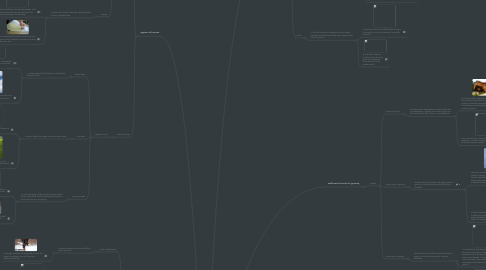
1. Types of forces
1.1. Internal forces
1.1.1. Compression
1.1.1.1. A force that pushes and compress a certain object
1.1.1.1.1. An example of compression would be ...anything that can be compressed, for example this is a thing that compress the green part.
1.1.1.1.2. A man pushing a car causes compression, the car's back got compressed by the man's arm strength.
1.1.2. Shear
1.1.2.1. A force that bends a certain object by the sides creating a upside down U shape if it's soft.
1.1.2.1.1. A Rubik's cube feels shear when a person turns the sides of it. The sides goes opposite direction when a person is turning a side.
1.1.2.1.2. .
1.1.3. Torsion
1.1.3.1. A force that get twists a certain object by the sides.
1.1.3.1.1. This is a piece of art that made by twisting the sides and turned into this shape.
1.1.3.1.2. This woman is doing exercise by twisting her body, she turned her body to stretch her back .
1.1.4. Tension
1.1.4.1. A force that a object feels when getting pulled on the 2 oppsite sides.
1.1.4.1.1. A person is bending a coin by using hands. The coin's both sides gets bended and also feels compression when you are bending.
1.1.4.1.2. A person is bending the paper using one hand. The paper will feel stretched because the hand is bending one side.
1.2. External forces
1.2.1. Types of loads
1.2.1.1. Dead loads
1.2.1.1.1. A certain object that holds live load and feel dynnamic load.
1.2.1.2. Live loads
1.2.1.2.1. A certain object that apply forces on dead loads.
1.2.1.3. Dynamic loads
1.2.1.3.1. A force that apply forces on live loads and dead loads, dead loads can be destroyed by dynamic loads if the force is too strong.
2. Applying forces
2.1. Point of application
2.1.1. A position where a structure with the forces around it.
2.1.1.1. The eagle grabbed the prey with its claw, the eagle is applying force on the prey's middle-top's body.
2.2. Speed
2.2.1. A pace of when objects are able to move accordingly.
2.2.1.1. An example of slow speed object, a turtle move really slowly because of its legs are short and its shell is too big.
2.2.1.2. An example of mid-fast speed object, a man is running fast by using his leg muscles.
2.3. Plane of application
2.3.1. A particular way of applying force in different directions.
2.3.1.1. The ball is getting kicked by a person 90 degrees.
2.3.1.2. A person got punched by another person 90 degrees .
2.3.1.3. The hammer is applying force on top-center of the nail.
3. Types of structures
3.1. Solid
3.1.1. A solid structure is when a structure is solid all the way through, the structure itself cannot store anything.
3.1.1.1. Here is another example of a solid structure all the way through
3.1.1.2. Pyramid is a solid structure because the pyramid is solid all the way through, the structure have no space inside it.
3.2. Frame
3.2.1. A frame structure is when strength is added to a frame to support the structure.
3.2.1.1. This frame of a house is the base. It will hold the house after its finished because it's strong and stable.
3.2.1.2. This is also known as another frame structure since it is protecting the inside just like a house would.
3.3. Combination
3.3.1. A combination structure is a structure that have different structure mixed inside, solid, frame and shell. Most structure are made out of combination structure.
3.3.1.1. An example of a combination structure would be a
3.3.1.2. This is an example of a combination structure is a stadium. It is a combination structure because it has a mixture of different materials used to get built as one structure.
3.4. Shell
3.4.1. A shell structure is a strong and have a empty storage, shell structure needs less materials than other structures.
3.4.1.1. A bee hive have a lot of little holes as rooms for bees to live in also made with very little materials
3.4.1.2. This is also known as another frame structure since it is protecting the inside just like a house would.
4. Different levels of gravity
4.1. Gravity
4.1.1. Center of gravity
4.1.1.1. structures with wide bases and skinny top have an advantage of getting the center of gravity in the center which will carry on a equal balance
4.1.1.1.1. This is an another example of a building that has a center of gravity, this picture is a good picture to describe how center of gravity. This building is upside down but still has center of gravity.
4.1.1.1.2. This is an example of a structure with a center of gravity. A center of gravity always helps a structure balance properly.
4.1.2. High center of gravity
4.1.2.1. Skinny and tall structures have high center of gravity. So the structure would likely to be unstable.
4.1.2.1.1. This is an example of a structure with a high center of gravity. A thin structure it will not be able to balance as much as the structures with a wider base. It is just a building but has a different center of gravity.
4.1.2.1.2. An other example of a structure that is of high in center of gravity is... "BURJ KHALIFA " known as the tallest building in the world this building which has a higher center of gravity.
4.1.3. Low center of gravity
4.1.3.1. Thick and short structures have low center of gravity. So the structure would likely be stabilized.
4.1.3.1.1. An example of a structure that has a low structure of gravity is a tree. These examples not only imply to objects but also human beings , if they are short than they have a low center of gravity same goes with different levels of gravity.
4.1.3.1.2. This is an example of a structure that has a low center of gravity. This structure also has balance than all the other structures.

